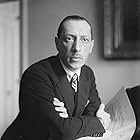Looking at the history of cinema from the documentary film's point of view, in 1960's it was going through a new breakthrough time. Already in the 50's television started to dethrone cinema and in the early 60's it caused the fall of many studios. Television also meant new technology, which allowed people to do different kind of films. Hand-held-camera and small sound equipment - before this most of the documentaries were filmed with a silent camera (sound added later on). This new equipment made it possible to go inside small places and make more 'personal' films, this "genre" or artistic movement is called Direct Cinema.
One of the most famous representative of Direct Cinema is Crisis: Behind a Presidential Commitment (1963), which showed John F. Kennedy in a more personal way than any film had. One could argue about A Stravinsky Portrait being Direct Cinema, but I think it is. Because it let's us in Stravisnky's personal life, the hand-held camera-work makes us feel that there is no camera, it feels that we are actually there.
The film is a portrayal of Igor Stravinsky. One of the most influential composers of the 20th century. A Stravinksy Portrait entails some unique small talk, not unique for us to hear but to see in cinema. It is so real and the viewer can feel the friendship between Stravinsky and the people around him. The film is very revealing and because of that very interesting for people who are interested in Stravinsky's music and life. I, personally am not very familiar with him, even that I do practice some music, I watched this from a cinematic point of view. Which fit perfectly, it works as an interesting example of Direct Cinema, from the era when television started getting more and more popular. These kind of portraits are very popular these days, but they actually aren't even close as revealing as this. A very revealing documentary, which is not just for fans of music or Stravinsky, also for film researchers, buffs and fanatics.




